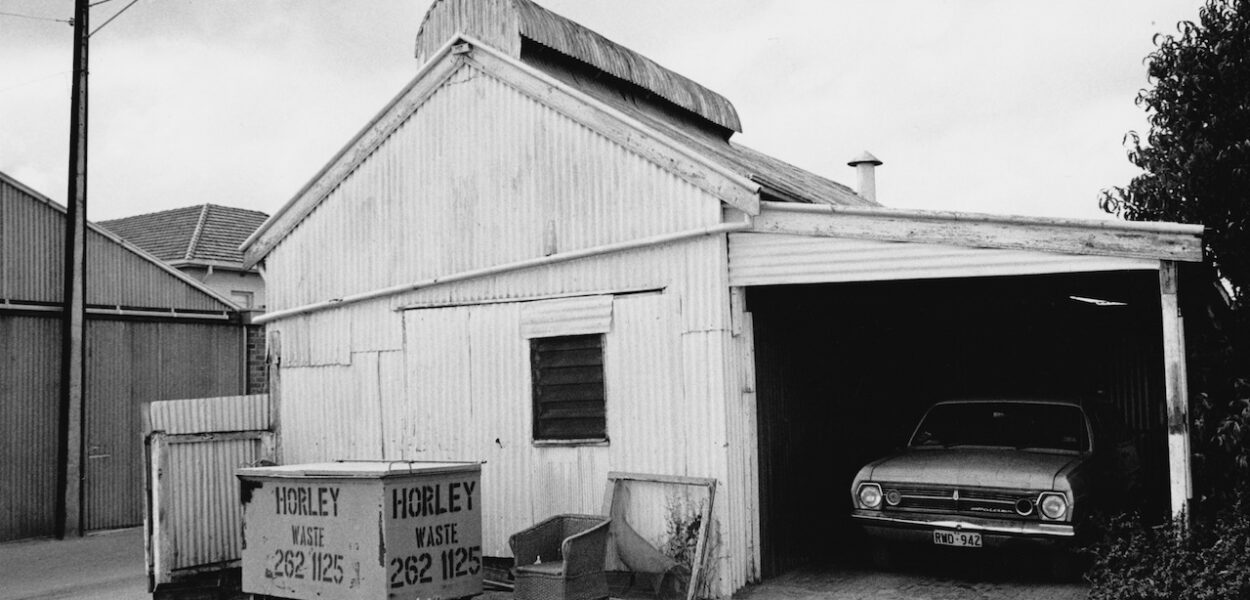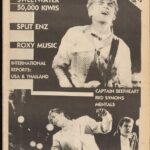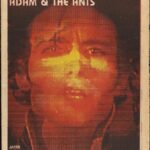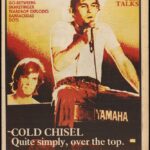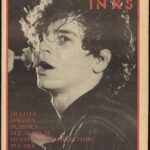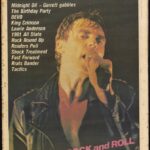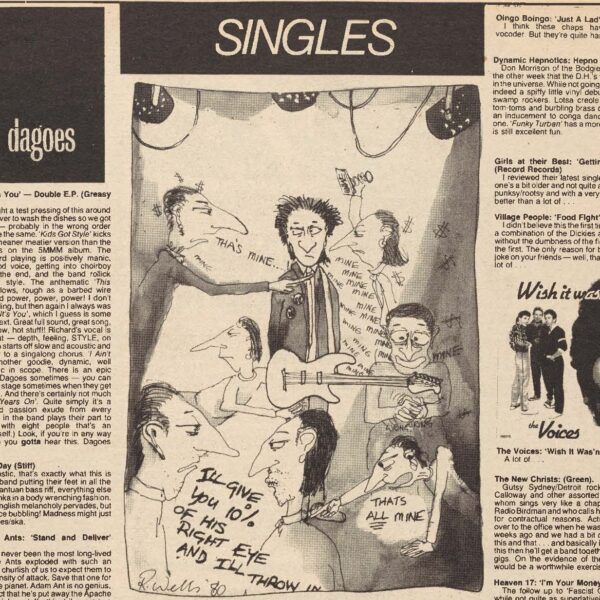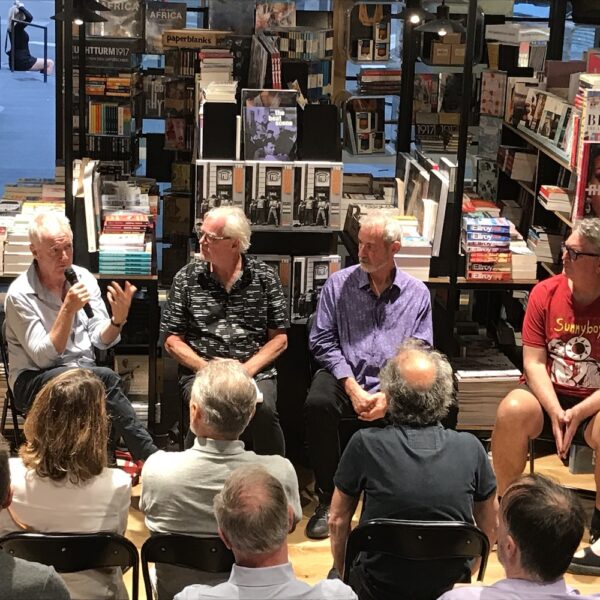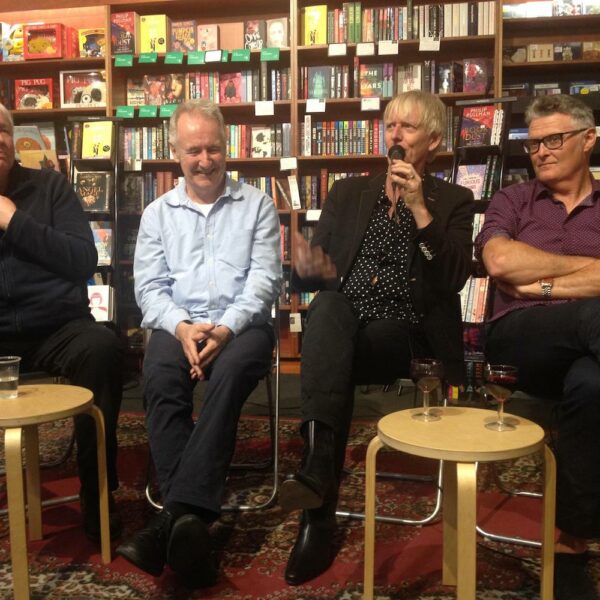To view and download issues, click on thumbnails below
- February 1981
- March 1981
- April 1981
- May 1981
- June 1981
- July 1981
- August 1981
- September 1981
- October 1981
- November 1981
- December 1981
Roadrunner‘s first issue of 1981 (Vol 4 No 1) signalled some changes. First, the cover price went up from 60 cents to 80 cents. We attempted to offset this by a bumper subscription offer—two free albums (Vinyl Virgins, a Virgin Records Australia sampler and Tactics’ My Houdini) plus a year’s subscription (12 issues) for $15. The offer snared 61 new subscribers, netting $915, the magazine’s best ever subscription drive.
Secondly, over the summer the magazine moved into a ramshackle metal shed out the back of G & S Management’s office at 103 King William Street, Kent Town. It certainly wasn’t much to look at from the outside, but inside it had electricity and phone lines. We got these connected, installed two phones and three desks, and decorated the walls with rock posters—sweet!
And thirdly, Giles Barrow joined the magazine. Barrow’s role was described as ‘Office’, which as well as basic office admin included deliveries around town and driving artwork up to the printer in Murray Bridge in his battered Holden HK Premier station wagon. Barrow also wrote under the pseudonym ‘John Doe’. He had the pulse of the Adelaide music scene and was familiar with most of the bands around town. He also wrote features and reviews—all in his inimitable sardonic style. I very much enjoyed his turn of phrase, so from the May issue onwards gave him his own column, ‘John Doe’s Ruined Scene’. The first column, titled ‘Iconoclasts 4: Albatrosses: nil’, began:
‘I’ve been abused in local punkzine D.N.A. for calling weak-headed Bombay Rock punks “weak-headed Bombay Rock punks”. Crime, sin. Some people just can’t stand the sight of real fruit juice.’
Loved your work, Giles.
David Pestorius took on the role of Brisbane contributor vacated by Scott Matheson. His first contribution was a roundup of 1980 in the capital of the Sunshine State—a year he described as ‘rather eventful’. Pestorius, who hosted a weekly new releases show on community radio station 4ZZZ, contributed a steady stream of live and record reviews through the year. He also sent a feature piece on The Go-Betweens for the April issue, catching Robert, Grant and Lindy preparing to record their debut album.
The rest of the writing line-up seemed quite settled: Stuart Coupe in Sydney; Adrian Ryan in Melbourne; Kim Williams in Perth; Keith Shadwick and Chris Willis in London, soon to be joined by my landlord and cobber Larry Buttrose; and a clutch of reviewers including Craig N Pearce, David Langsam, Goose, Tyrone Flex (a.k.a. Peter Jolly from Adelaide band Nuvo Bloc), Span Hanna and Adrian Miller.
On the production side, Clive Dorman folded his Neighbourhood Typesetting venture and typesetting transferred to SA Type Centre. Design and layout continued to be handled by Richard Turner and Kate Monger of AND Productions, who moved across Rundle Street with Geoffrey Gifford’s Modern Art to a much larger, airier first floor studio at number 255 above Ruby’s Café.
On 20 February, Keri Phillips wrote from New York offering to provide articles and regular reports on the NY scene. I had met Keri a couple of times in Sydney when she was working as an announcer at 2JJ/JJJ-FM and had published her interview with English rock journalists Tony Parsons and Julie Burchill of the New Musical Express in the August 1979 issue. She told me that JJJ had decided to severely limit ‘spoken word’ interviews and she was looking at ways of using the interviews she was doing. I accepted with alacrity.
The March issue had a striking cover of Adam Ant, a manipulated television image of the new King of the Wild Frontier. April’s cover featured an Eric Algra photo of Cold Chisel’s Jimmy Barnes and Don Walker, a black-and-white live shot treated with red and yellow spot colour. The story was an interview I did with Don Walker in Sydney’s Paradise Studios a few days after the notorious TV WEEK Rock Awards when Chisel had trashed their equipment onstage at Sydney’s Regent Theatre.
Midnight Oil rolled into town in early March for the Adelaide University Orientation Ball. Along with Terry Bradford and Paul Storey from 5MMM, I interviewed Peter Garrett at the band’s North Adelaide hotel ahead of its blistering performance on the Barr Smith Lawns that night. I waxed lyrical in the piece that appeared in the June issue, proclaiming, ‘It was awesome, brilliant, the closest to a perfect rock gig I’ve ever seen.’
The Reels decorated the cover in May, with a typically dense and challenging story from Craig N Pearce. Pearce also had the lead album review, The Birthday Party’s Prayers On Fire. The issue included the first of Keri Phillips’ many top quality ‘New York, New York’ columns. Phillips also submitted a feature on former Ronette Ronnie Spector.
Buttrose had fetched up in London at the turn of the year, from where he had been contributing the odd piece—on the Brixton riots, surf punks The Barracudas and ANZAC Day with the Australian Labor Party among others. Buttrose had been right on to CBS Records in London about getting a Bruce Springsteen interview for Roadrunner when the Boss’s The River tour hit Europe in the northern spring. The tour was a big deal—Springsteen’s first overseas performances since the four European dates he played in 1975 following the release of Born to Run. But Buttrose had hit a brick wall in the person of CBS London staffer Kit Buckler. ‘Now this boyo says not only will I probably not get an interview,’ Buttrose wrote to me, ‘but it’s no-go even on some fucking tickets.’ Buttrose implored me to apply some back-channel pressure via CBS Australia.
The River tour was supposed to hit the UK in mid-March for 12 dates, but the first leg of the tour—with Springsteen pumping out four-hour shows night after night across the US and Canada from October 1980 to March 1981 (a punishing 72 shows in five months)—had left the Boss exhausted and the UK shows were rescheduled for May, at the end of the European tour.
Meanwhile, there were persistent rumours that Springsteen would tour Australia in 1981. The catch was that the Boss wanted a million bucks. And at that stage, he wasn’t a big record seller down under—or anywhere apart from the States. One night in Sydney, at a Charlie Daniels party-cum-record presentation, Coupe was chatting to new CBS Australia head honcho Paul Russell. ‘We think we need someone to go to Europe and tell people in Australia what Springsteen is like live,’ Russell told Coupe. ‘Do you think you could find the time to go over?’
‘Are you kidding?’ lifelong Boss-fan Coupe responded. ‘I would walk over broken glass!’
So Coupe called me. Did I want the story? Absolutely. He had tickets for three of the London shows in March. Which then were blown out. So it was two shows in Paris instead, 18 and 19 April. And an interview after the second show. Coupe went to New York for three weeks, then on to Paris, flew home, delivered a ten thousand-word magnum opus and Springsteen graced the cover in June 1981. We were quite up front about the largesse. The subhead ran: ‘Stuart Coupe finds the key to the universe in a trip to Paris paid for by CBS.’
Oh, and Buttrose eventually wangled tickets for one of the May shows in London and sent a glowing full-page review for the July issue.
Scott Matheson had returned to Roadrunner‘s pages in May with a review of Radio Birdman retreads New Race (supported by The Church) at the Family Inn, Rydalmere, deep in the Sydney suburbs. His interview with INXS singer Michael Hutchence in the August issue (with a live shot of Hutchence by Eric Algra) was the first cover story INXS had ever had. The first of many. ‘A Star Is Born’ was the story’s headline, and it was true.
Another new face graced the cover in September—Jeremy Oxley of Sunnyboys. Coupe had been singing their praises as a live act for some time and with a debut album produced by rock legend Lobby Loyde in the shops, Coupe’s cover story lauded them as a blast of fresh-faced (power)pop.
And from the dust of the Adelaide ‘fanzine war’ of winter 1981, a new name emerged in the contributors’ list. Toby Cluechaz was editor and publisher of The Archangel, a new ‘zine on the scene, and he and Giles Barrow bonded over their mutual admiration for the new sounds blossoming in Adelaide’s pubs. After a bit of on-page ribbing between Barrow, Cluechaz and Harry Butler of DNA, Cluechaz dropped into the College Street office and shortly thereafter started producing a steady stream of erudite reviews and articles for Roadrunner. With Harry Butler’s help, I tracked him down recently and along the way discovered his real name had been John Buchan all along. Thirty-nine steps indeed.
* * *
From the March 1981 issue, Roadrunner had grown in terms of pages. In 1979, every issue of the magazine had been 24 pages, except the 48-page December/January double issue.
In 1980, most issues were still 24 pages, but three featured 32 pages. October was only 20.
In 1981, each issue from March to July was 32 pages. August dropped back to 24 pages, but then September was 40, October was 48, November was 40 and the end-of-year double issue was the biggest ever, at 64 pages.
What happened? Lyn Saunders, the magazine’s advertising manager, persuaded me that he could sell more advertising and organise more promotion if he was based in Sydney. It made a lot of sense. Almost all the major record companies were based there and, more and more, they were the ones booking ads. I did have my reservations. Saunders—who was tragically murdered outside Mildura while hitch-hiking from Sydney to Adelaide in 1987—was possessed of boundless enthusiasm, but I felt he often lacked judgment. Working closely with him in Adelaide was one thing. I felt I could channel his enthusiasm. Letting him off the leash and loose in Sydney was another matter. It was a risk, but one I decided to take.
Why? The magazine was still in a precarious financial position. Newsagency sales for the first seven issues of 1981 averaged 4230—stuck stubbornly close to the 1980 figure of 4309. Ad sales were also flat. There wasn’t enough in the bank to pay G & S Management for their accountancy services in August so we quit the shed at the back of their office. We remained on friendly terms—it was just business—and moved into a one-bedroom terrace around the corner at 2 College Road, Kent Town that they managed on behalf of the owners—The Angels. Giles Barrow moved into the bedroom. And G & S Management took the debt matter to court and eventually (about a year later) won a certificate of judgment for the amount of $847.85. Whatever that meant.
An abiding memory from 2 College Road was doing the singles reviews. This was a fun job I’d usually leave to the last possible moment—mainly because there was so much else to do, but also to make the column as current as possible. Once business hours were over, I’d toddle up to the Maid and Magpie Hotel at the junction of Magill, Payneham and Fullarton roads and buy a bottle of Stone’s Green Ginger Wine. Can’t remember why and I never drank it at any other time—go figure!
I’d come back to the office, set up my typewriter on the kitchen table, sort the singles into some sort of order, pop the first one onto the turntable, drop the needle, have a sip of the GGW and type the first thing that came into my head. Repeat 25 times and hey presto! —an empty bottle and a singles column.
Lyn Saunders hit Sydney running and quickly tied up a deal with Polygram Records that saw newly-signed Polygram band The Eighty-Eights on the cover of the full-colour 40-page September issue. There was also a ‘poster’ of The Jam in the middle of the magazine. A slight problem—the ‘poster’ was a blown-up blurry black and white photo that art director Richard Turner did his best to jazz up with some semi-tone treatments. A bigger problem. Who the hell were The Eighty-Eights and what were they doing on the cover of Roadrunner? And who was ‘Ronnie Raver’, the author of the rather lame Q & A with the band? There was more than a whiff of advertorial and payola around the whole scheme.
The rest of the issue was great—a feature on The Ramones from Keri Phillips in New York, a double-page spread on Malcolm McLaren from Chris Salewicz in London, a double page on John Dowler from Adrian Ryan in Melbourne and more. But as Michael Samaras from West Wollongong put it in a letter we printed in the next issue:
‘I noted with some degree of amusement the 88s on Roadrunner’s September cover and the featuring “interview” and full-page picture. (Incidentally, who is Ronnie Raver? The 88s manager?)
‘Further amusement was obtained when I read that the 88s go “through” Polygram and then examined the delightful 4-page Jam Poster with “Polygram” tucked oh, so coyly in the corner.
‘My amusement soon turned to disgust when I re-read the Roadrunner No. 3 (June 1978) editorial which referred to, in part, the editors (Stuart Coupe and Donald Robertson) fascinating “experience of dealing with the people who’s (sic) job it is to sell the product … “Look, I’ll take out a full-page ad each issue for 12 months if (so and so) are on the cover”.
‘O.K., so maybe June 1978 is a long time ago and maybe the Polygram connection between the Jam overkill and the 88s overkill is a simple, if frightening, coincidence; and maybe the Stuart Coupe—CBS—Bruce Springsteen connection can be overlooked.
‘But maybe not.’
Fair cop, guv.
The same promotional package was sold to EMI for the October issue—when the cover price increased to $1. Recently arrived Kiwi band The Tigers were on the cover and there were black-and-white posters of Ward 13 (really?) and Australian Crawl inside—but that was it. I killed the idea. The end didn’t justify the means. It had damaged the magazine’s credibility—though not irreparably, I hoped.
It seemed all too much for Coupe who handed over the baton of Sydney editor to Scott Matheson. Matheson lasted only a few issues before Giles Barrow moved up from Adelaide over the summer to take the chair.
The final two issues of the year both sported full-colour covers—but chosen on editorial merit, not as part of a paid promotion. Iva Davies of Icehouse and Jim Kerr of Simple Minds chatting in a London street ahead of their joint Australian tour featured in November, and Doc Neeson of The Angels appeared on the December/January double issue.
In Sydney Lyn Saunders switched his efforts to promotion, organising an ad to run late night on Channel 7 and radio ads to play on 2MMM. That end-of-year issue was the largest, at 64 pages, and highest selling (5853) to date. The sales in New South Wales almost doubled—from 1665 in November to 3169.
The future looked rosy—but there were clouds on the horizon.


